There’s no doubt that when the E60 Five first burst on to the scene back in 2003 it was a bit of a shock to the system – it looked like no other BMW before it (or since) – and both externally and inside it took a bit of getting used to. Time, though, is a great healer and it didn’t take long for us to become accustomed to it. As you’d expect from the purveyor of The Ultimate Driving Machine it was an excellent steer and we can still remember being blown away by the car’s pace and poise when we first drove the E60 530d on the car’s international launch.
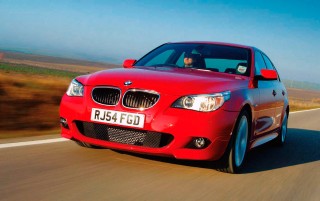
Even today an E60 wearing the M Sport kit and in a decent colour is still an arresting sight to our eyes with the styling looking fresh and distinctive. On the other hand a low-spec car in a dowdy colour sitting on a set of small rims looks rather dated to us – it’s amazing how the spec of a car can alter its looks so much. If looks come rather low on your list of priorities these lower spec cars can offer excellent value for money and don’t forget small wheels equate to a significantly better ride!
Today we’re going to concentrate on the six-cylinder diesel models – there’s nothing wrong with a 520d, but at today’s prices the six-cylinder machines do represent excellent value for money with very decent performance. Buy wisely and you’ll be equipping yourself with an excellent family saloon that can be frugal when necessary and pretty sporting when the mood takes you.
When the new Five arrived in the UK in September 2003 the only diesel in the line-up was the 530d and it could only be ordered in SE spec at a cost of £30,955. It offered a pretty exceptional set of figures for its day with 218hp, 369lb ft of torque and a 0- 62mph time of 7.1 seconds, and all this while offering 40.9mpg and CO² emissions of 184g/km. The 525d joined the party shortly after and used a 2497cc version of the 530d’s engine to develop 177hp and 295lb ft of torque – still good enough for an eightsecond 0-62mph time and over 40mpg. Standard spec wasn’t too shabby with all cars featuring iDrive, auto air-con, part electric seats, eight air bags, rear PDC and metallic paint. There were a host of extras that could be added like Business and Professional navigation, Active Steering, Dynamic Drive, Adaptive xenons, Sport or Comfort seats, massage seats, Active cruise control, Nasca or Exclusive leather trim… the list was seemingly endless.
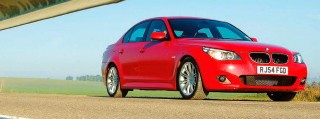
The first major change to the E60 was the arrival of the Sport models in mid-2004. Taking its styling cues from the recently announced M5, the Sport models featured an M aero kit, M Sport suspension with recalibrated dampers and stiffer springs (which lowered the car by 15mm) and 18-inch alloys. Inside there was the familiar mix of Sports seats – clad in a leather/Alcantara mix in this instance (although most were updated to full leather) – aluminium cube trim, M Sport steering wheel and an anthracite headlining. Depending on model the Sport trim level attracted a price premium of around £3000.
The range-topping twin-turbo 535d arrived late in 2004 and it packed a real punch with 272hp and 413lb ft of torque. Its 0-62mph time of 6.5 seconds only told half the story as it was the car’s prodigious mid-range urge that made it such a quick car across country. It’s a testament to the rapid progress that’s been made with diesel technology over the last ten years or so that these figures are no longer anything to write home about, but back in 2004 the 535d was a real eye-opener. Prices started at £36,575 for the SE model and rose to £39,300 for the Sport-equipped machine.
The biggest change to the E60 range occurred in March 2007 when it went through its mid-life face-lift which saw some styling tweaks, new engines and the adoption of a raft of the then-new EfficientDynamics technologies. For the diesel models the 525d adopted the 3.0-litre unit in a detuned form to give 197hp. It was half a second quicker to 62mph yet saw economy improvements between 11 and 21 percent (manual and auto transmissions respectively). The 530d’s gains were (on paper) less spectacular with just a 4hp gain yet the auto was 13 percent more economical and thanks to a greater spread of torque the engine was more flexible, too. For the 535d power rose by 14hp to 286hp and torque swelled by 15lb ft. Performance was marginally better but economy was a significant 17 percent better.
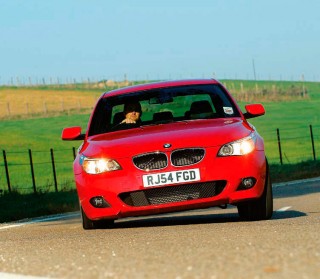
Externally the new car could be spotted by subtle changes to the headlamps and the kidney grilles while at the rear the light clusters now featured LED rods while the numberplate carrier panel was also redesigned. Inside the front door trim panels were reshaped and the window switches were relocated while the iDrive gained eight ‘favourite’ buttons to allow rapid access to the most frequently used items. Automatic LCI models can be easily recognised by the new style gear lever, too.
Just about the last update to the Five came during its twilight years in 2009 when a Business Edition was launched for the 525d and 530d. This could be spec’d on both the SE and M Sport models for a premium of £1750 and added Dakota leather, Bluetooth with telematics Professional Multimedia Navigation, extended voice control and a USB audio interface along with a set of 19-inch wheels.
Despite its slightly rocky start the E60 was a hugely popular machine in the UK and there were many fans who mourned its passing when it was replaced by the F10 generation in 2010.
Engine
Rather than use the existing M57 from the E39, the E60 diesels used the revised M57N as first fitted to the revised face-lifted E46 330d earlier in 2003. As well as the extra power (the 3.0-litre had started with 184hp), the main change was in the way the cams were driven. On the E39 M57 unit, a chain drove both cams that rotated together in the same direction – the chain was driven off the diesel pump that in turn was driven from the crankshaft with a short chain. On the M57N, this was revised with the new cam design taken from the 2001-onwards 150hp M47N 320d motor. The short chain from the crank still drives the diesel pump and a chain still goes up to the cams – but this time the chain only drives the exhaust cam, and a gear on the front of the exhaust cam drives the inlet cam so that whilst the exhaust cam turns clockwise, the inlet cam turns anti-clockwise.
| BMW | 525d | 525d LCI | 530d | 530d LCI | 535d | 535d LCI | |
| ENGINE: | Straight-six, 24-valve | Straight-six, 24-valve | Straight-six, 24-valve | Straight-six, 24-valve | Straight-six, 24-valve | Straight-six, 24-valve | |
| CAPACITY: | 2497cc | 2993cc | 2993cc | 2993cc | 2993cc | 2993cc | |
| MAX POWER: | 177hp @ 4000rpm | 197hp @ 3750rpm | 218hp @ 4000rpm | 235hp @ 4000rpm | 272hp @ 4000rpm | 286hp @ 4400rpm | |
| MAX TORQUE: | 295lb ft @ 2000rpm | 295lb ft @ 1300-3250rpm | 369lb ft @ 2000rpm | 369lb ft @ 1750-3000rpm | 413lb ft @ 2000rpm | 427lb ft @ 1750-2250rpm | |
| 0-62MPH: | 8.1 seconds (8.3) | 7.6 seconds (7.7) | 7.1 seconds (7.3) | 6.8 seconds (6.8) | (6.5) seconds | (6.4) seconds | |
| TOP SPEED: | 143mph (141) | 147mph (146) | 152mph (151) | 155mph (154) | (155) mph | (155) mph | |
| ECONOMY: | 42.2mpg (36.2) | 45.6mpg (43.5) | 40.9mpg (36.2) | 44.1mpg (42.8) | (35.3) mpg | (41.5) mpg | |
| EMISSIONS: | 179g/km (208) | 165g/km (172) | 184g/km (208) | 170g/km (176) | (211) g/km | (182) g/km | |
| PRICE (NEW): | £29,535 (2004) | £30,375 (2007) | £30,955 (2003) | £34,635 (2007) | £36,575 (2004) | £39,045 (2007) | |
| Figures in brackets refer to six-speed automatic gearbox |
|||||||
There are three basic engines in this series: the pre- LCI 525d with 2.5-litres, the 530d (3.0-litre single turbo) and the twin-turbo 3.0-litre 535d. LCI cars were all 2993cc with varying power outputs from 197hp (525d) through to 235hp (530d) and finally 286hp for the 535d. The basic engines are very similar on all three but the 530d and 535d short engines do not interchange. There are few problems – if any – with the M57N. There have been mutterings of timing chain breakage at high mileages – we’ve heard of this happening at 150,000 miles but the vast majority of cars that have got to 200,000 miles and beyond have been no trouble. As ever, regular oil changes are key and never mind what the service indicator says – 10,000 miles or a year is plenty for a sumpful of oil.
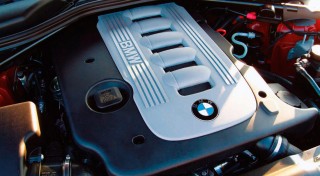
As with all modern common rail diesels, it’s the ancillaries that cause the problems. Swirl flaps have been well-documented and they should be removed and blanks fitted because if one of those breaks loose, it’s carnage. Whilst you’re in there, replace every vacuum pipe in sight and removing and completely cleaning out the EGR valve every year is an excellent idea – EGR delete is controversial as EGR does in fact lower combustion temperature. Keep it clean and it’ll work fine. Slow coolant loss can be a leaky EGR cooler – the coolant drips out and is ingested into the engine and whilst it’s not enough to cause a catastrophe, it needs fixing. Most E60 diesels will have a DPF (diesel particulate filter) as well and you may find a car where it’s been removed. If that’s the case, you’ll need a friendly MoT man who will overlook this as well as proof that the ECU has been modified to fool the system into thinking it’s still fitted. Poor cold starting can be due to either tired glow plugs or a failed glow plug controller.
Injectors are pretty reliable, and if they do pack up they are rarely as bad to replace as folk say but you’re looking at between £210 and £400 each for new ones depending on the part number. The high pressure pumps are quite hardy and so are the inline/in tank feed pumps but the MAF can fail – if it’s not quite ‘right’ it’s worth scanning for fault codes but only fit a Bosch MAF – they’re around £300 but the aftermarket ones are often useless.
Turbos are reliable enough on the 525d and 530d cars although nothing lasts forever – these are electronic actuator units and you’re looking at £1000 to supply a good reconditioned unit with a Mellet core plus three hours labour to fit. A turbo from BMW will be around £1650 plus fitting. 535ds are less happy; whilst they are generally okay, most of these cars have been driven hard and you are into around £3000 to supply and fit a pair of turbos – from BMW, the turbos are £2800 before fitting. However, the 535d uses a cast iron exhaust manifold, unlike the 525d and 530d that use a crack-prone pressed and welded steel manifold – those can be replaced by one of the many aftermarket cast iron replacements now available. They cost around £70 but the labour to fit one will amount to at least a couple of hours – probably more.
Watch out also for a delaminating rubber bonded front crankshaft damper too, hardly a bargain at £416. The M57N cooling system is pretty straightforward and presents few issues. A new radiator is best bought from BMW at £351 plus fitting although Nissens are probably the best of the aftermarket rads. Diesels run cooler than petrols anyway, and the thermostat needs to be spot on if anything like decent fuel economy is to be achieved – from BMW a coolant stat is only £55 and the EGR thermostat is cheaper still at just £37 – it’s worth replacing both at the same time. Water pumps rarely fail too. That sums up the M57N – maintain it religiously, and it’ll be a great engine. Buy one that’s been run on a shoestring and it will bite you.
Buying one
The world’s your oyster when it comes to buying a diesel E60 – there are a lot of them around so there’s no need to rush, look at several before you take the plunge and get to grips with the options list before you buy as there are some that are worth having and some that are worth avoiding.
Prices start at a bit over £2000 and rise all the way up to the mid-teens. At the former end of the scale you’ll be buying a machine originally ordered by Captain James T Kirk – it’ll have starship mileage and will probably be a whole heap of wallet-witling trouble. At the other end of the scale you’ll be looking at a low-mileage pampered BMW Approved Used example – but be aware that at this end of the scale you could be buying a rather nice F10 Five so you’d have to really want an E60 to pay this much.
Somewhere in the middle of these two figures you should be able to bag a sub-100k mile 530d Sport that will provide many more miles of executive saloon wafting while providing plenty of enjoyment, too.
Body
The E60 was a huge step forward over the E39 for rust resistance, and 13 years after its launch we’ve yet to see a rusty one. Cars that have lived in harsh climates can resemble the Titanic underneath but the actual body will be fine. E60s had full aluminium front ends but many cars that have been repaired after a front ender will have the cheaper steel bonnet fitted. That won’t affect the handling or anything, but it will overpower the standard gas bonnet struts. Xenon headlights are well worth having because the standard halogens are so grim – you don’t realise how bad they are until you have to drive on a dark rainy night with a touch of mist. But adaptive xenons are both slightly fragile (one severe pothole can dislocate internals) and incredibly expensive – try £1250 for size!
Apart from that there are few problems – the scuttle drain holes need cleaning out periodically otherwise water will enter the cabin as well as damaging ECUs – it’s a simple DIY task though. Window regulators don’t break often and a new one from BMW is a reasonable £181 if you don’t want a used one. Wiper linkages seem more fragile on LCI cars for some reason but it’s not a widespread fault.
Steering and suspension
This is all regular E60 and thankfully, few owners specified either active steering (ECU controlled for sharper turn-in) or active ride (hydraulic computer controlled anti-roll bars). Both were expensive options that weren’t really of much benefit to the already sharp handling E60 and both offer mind-blowing expense should they go wrong – an active rack is around £2500, the ECU around half that whilst the active anti-roll bars can leak – an MoT fail with similarly crippling repair costs.
Check the spec of your intended purchase with your local dealer, and just don’t go there – both options were eventually discontinued around the time the LCI models arrived. Standard and M Sport non-active stuff is all as tough as old boots. Dampers seem to last indefinitely and when they do require replacement, they don’t cost a lot from the aftermarket – around £260 all-in for a pair of Boge Sachs, arguably the best quality dampers available and of course, BMW OE. Anschler dampers from ECP have a good reputation though and are just £75 each – decisions, decisions!
Bushes will wear out, of course, particularly the rear ones on the lower ‘H’ arms that are best renewed as complete units – those are £950 new from BMW for a pair although cheaper aftermarket versions are available. Should you require any suspension arms both front and rear, only Lemforder or Febi stuff is worth having really – the fact that so much of it was BMW OE and that they’re a lot cheaper says it all.
Transmission
Most of these cars are automatics with the excellent ZF 6HP unit. These last well with little maintenance – as long as there are no oil leaks they are capable of 200,000 miles or more although some will experience problems before then. These boxes use finned plastic sumps and these will eventually warp and start to leak, as will the rubber sealing sleeve for the wiring plug. However, to replace both items and refill with the correct oil is not going to cost much more than £400 but don’t try and shortcut by buying a non genuine sump kit (the sump contains the filter) This is because too many aftermarket sumps – even those with reassuring names – will warp and leak in a matter of days or weeks rendering the whole job a waste of time. In short only buy from a BMW dealer or accredited ZF parts supplier. Autobox problems can be due to low battery voltage or a charging issue, the rubber bridge seal between the mechatronics unit and the transmission casing or solenoid problems. None of these will be cheap to fix (although a bridge seal replacement will be way under £500) so you might consider a manual to be a better bet – 535ds were all autos alas.
These are all six-speed units and the Getrag GS6 is as close to unbreakable as you can get. Similarly, the dual mass flywheel on these has an easier life than the four cylinder stuff and replacement is rarely required – a new LuK flywheel will be around £450 aftermarket and as these are OE fitment, forget going to the dealers. Should you need a clutch, the cost will be £375 for an LuK or Sachs boxed clutch kit from the aftermarket.
Differentials and driveshafts are nigh-on unbreakable and even if you did need either, you’d buy used due to the strength of the parts – there is just no need to buy new, especially considering the eye-watering cost!
Interior
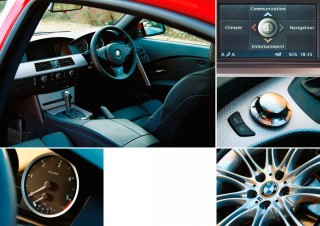
The E60 was panned for its interior design and after the E39, it took some getting used to. A lot of it was down to unfamiliarity and today, an E60 interior looks modern and fresh. Cloth trim was reserved for the basic models and there’s no excuse for it – leather is a must. There are various seat options such as Sport and Comfort seats, heated, cooled, electric with memory and so on but standard chairs are fine. The leather was good quality – should you need a new side bolster stitching into a driver’s seat, it’ll cost under £100 plus resetting the airbag light. Some of the interior trim plastics had a sprayed-on rubbery finish that will by now be peeling off but it’s possible to remove the affected parts; clean it back to the base plastic with thinners and paint it with a gloss aerosol paint. Failing that, new trim bits from BMW aren’t that expensive. All E60s have the central info display and iDrive – we’ll discuss those in ‘electrics’ later.
There are two types of air conditioning, standard climate control and fully automatic with automatic air recirculation and this system can be identified by having numbers from 16 to 26 around the left-hand rotary dial and ‘auto’ in the centre dial. Both systems are reliable with no real known faults – just the usual tired compressor or old, leaking condenser but neither are very expensive to fix. Handbrake ratchets are known to wear out and break, but a new lever isn’t too expensive at £78 from BMW.
Electronics
This is where most of the E60 maladies occur. First and foremost, the car must have a healthy battery of the correct size – you have a choice of 80, 90, 92 and 110Ah units. It must also be registered/coded to the battery control module – any discrepancies here and you will have an electrical system resembling a Seventies Alfa… only worse. You would be amazed at the number of cars with the intelligent battery system that have electrical troubles that a new, correct battery and proper coding will sort out.
Central to the iDrive and navigation systems is the CCC unit that controls it all. E60s are getting to the age now where these are failing and it’s not a cheap fix – BMW will relieve you of over £1000 to supply and fit one, whilst a good used one will be £300. The list of options on the E60 is mind-boggling – head-up display, soft close doors, electric steering column, heated steering wheel, glass sunroof, voice control for navigation and phone, active cruise and so on. It all needs to work but thankfully it all seems to be reliable and few problems have been reported.
Early E60 cars until the September 2005 build use the old style E39 key and steering lock, the one that never goes wrong apart from the batteries eventually dying in the key. After that, the E90 style key fob and starter button was introduced and these certainly can give grief. There are two warning lights – orange for ‘this needs attention’ and red for ‘call the AA’ and it’s down to the lock requiring at least recoding but increasingly now, stripping and cleaning before reassembly and recoding. LCI cars have LED rear lights that look nice but can be trouble later as LED bulbs fail – they’re better than the E90 units though and Hella replacement units are £195 each and thus a lot cheaper than BMW. On cars with sat nav, make sure the disc is there and that it all works as it should.
Wheels, tyres and brakes
Discs and pads aren’t too expensive – £130 for a good quality pair (ATE, Brembo) and £50 for a set of Pagid front pads. Master cylinders never seem to give trouble and ABS and DSC units are so reliable that it’s not worth considering new – a good used one will be a fraction of the cost. Brake pipes are known for going rusty; an older BMW trait that the E60 didn’t escape.
Should you need 535d parts, be aware that these cars used the bigger brakes from the 550i V8 petrol cars. Prices are higher as a result – £300 for a pair of front discs and £200 for a reconditioned front calliper.
Wheels and tyres range from the sorry 16-inch alloys on older 525ds through to the better 17-inch five-spokes and then through 18- to 19-inch wheels on the 535d. None have cracking issues – well, it can happen on the 19-inch rims but it’s not as common an issue as it was on the E90 3 Series wheels. Tyres are mostly run-flats (19s were normal) but more owners are ditching these and reverting to standard tyres with a spare. Spacesavers were an optional extra and cars that don’t have a spare wheel don’t have a jack or wheel brace – E39 jacks will apparently do the job though. A single alloy wheel and tyre won’t break the bank but the E60 wheel well isn’t deep enough for all sizes – we’ve seen various solutions such as raising the boot floor cover with a pre-cut foam section, or just laid in the boot with a vinyl 4×4 type spare wheel cover. Tyres for 18- and 19-inch wheels aren’t too expensive either – a pair of Continental 275/30×19 rears for a 535d Sport will be £365 fitted.
Servicing costs
The E60 is serviced on the CBS (condition based servicing) scheme, but we’d still advise an interim oil change, especially on a diesel. Servicing costs here are from BMW’s own website and are for a 2007 525d – others will be very similar, whilst specialist servicing prices are taken at random from three different specialists.
| SERVICE | BMW DEALER | INDEPENDENT |
| OIL SERVICE | £179 | £135 |
| OIL SERVICE AND MICRO FILTER | £199 | £165 |
| BRAKE FLUID | £110 | £75 |
| FRONT BRAKE PADS | £169 | £130 |
| FRONT PADS AND DISCS | £399 | £310 |
| VEHICLE CHECK | £79 | £75 |
Verdict
A good E60 diesel is a great car – when they were new the 530d was probably the car out of the whole range to have for its blend of economy and performance. The 525d is another excellent car that doesn’t give much away and is a nicer all-rounder than the 520d but we’d advise caution with the 535d – they’re a tremendous car but too many have been thoroughly beasted and the potential repair costs can be in the M5 league – a good remap on a 530d will give you an E60 that is more than fast enough and a standard LCI 530d is a rapid car already. Manual versions of the 525d and 530d are also plentiful although manual LCI cars are scarce – an LCI 530d M Sport manual would be a superb bit of kit. Overall? A great car, but if you’re thinking in terms of £3000, then an M54-engined 530i petrol might be a better (and cheaper) option.





